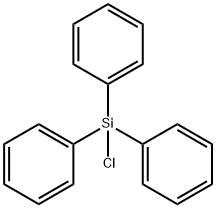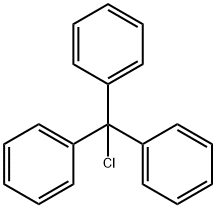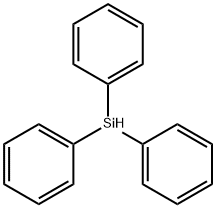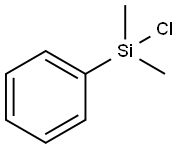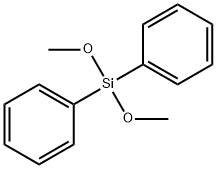Chlorotriphenylsilane , 95% , 76-86-8
Synonym(s):
TPSCl;Triphenylchlorosilane
CAS NO.:76-86-8
Empirical Formula: C18H15ClSi
Molecular Weight: 294.85
MDL number: MFCD00000496
EINECS: 200-989-0
PRODUCT Properties
| Melting point: | 91-94 °C(lit.) |
| Boiling point: | 378 °C |
| Density | 1.14 |
| Flash point: | >200°C |
| storage temp. | Refrigerator |
| solubility | acetone: 0.1 g/mL, clear |
| form | crystal |
| Specific Gravity | 1.16 |
| color | white |
| Water Solubility | Reacts with water. |
| Hydrolytic Sensitivity | 8: reacts rapidly with moisture, water, protic solvents |
| Sensitive | Moisture Sensitive |
| BRN | 1820487 |
| InChIKey | MNKYQPOFRKPUAE-UHFFFAOYSA-N |
| CAS DataBase Reference | 76-86-8(CAS DataBase Reference) |
| NIST Chemistry Reference | Triphenylchlorosilane(76-86-8) |
| EPA Substance Registry System | Silane, chlorotriphenyl- (76-86-8) |
Description and Uses
Triphenylsilyl chloride is a white to off-white crystal or powder with acrid ordor of hydrogen chloride, used for synthesis of pharmaceutical intermediates.
A wide variety of Grignard reagents and organolithium complexes participate in reactions with Ph3SiCl to afford organosilanes. Thus the reaction of allylmagnesium chloride with Ph3SiCl gives the allylsilane in high yield (eq 3).However, when hydrosilyl Grignard reagents are employed, reduction to the silane occurs (eq 4).Azaallyl anion6 and diazolithium salts can each be silylated to give the anticipated silane adducts (eqs 5 and 6). Similarly, arylsilanes8 and alkynylsilanes are produced upon silylation of the appropriate metalated13 carbanions with Ph3SiCl (eqs 7–11).
Safety
| Symbol(GHS) |  GHS05 |
| Signal word | Danger |
| Hazard statements | H314 |
| Precautionary statements | P260-P280-P303+P361+P353-P304+P340+P310-P305+P351+P338-P363 |
| Hazard Codes | C |
| Risk Statements | 34-37 |
| Safety Statements | 26-36/37/39-45-24/25 |
| RIDADR | UN 3261 8/PG 2 |
| WGK Germany | 1 |
| RTECS | VV2720000 |
| F | 10-21 |
| TSCA | Yes |
| HazardClass | 8 |
| PackingGroup | II |
| HS Code | 29310095 |

